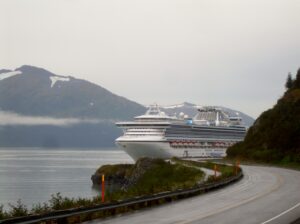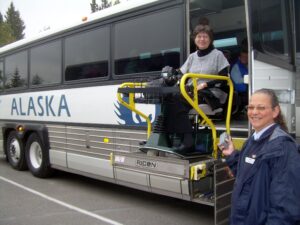“What I learned–How I did it”

October 12, 2013
I was extremely nervous prior to taking a 14-day land tour/cruise to Alaska because I am confined to a wheelchair. Though I can stand, I do not walk at all. When travelling in a wheelchair, there is always a glitch with something that is supposed to be ADA compliant and isn’t.
 My husband and I recently returned from a Princess Tour/Cruise package called “Off-The-Beaten-Path.” Our trip began in Anchorage, and then took us to Copper Center, Fairbanks, Denali National Park, Mt. McKinley and Talkeetna. We boarded the Princess Sapphire in Whittier and travelled southbound through the Inland Passage to Vancouver, with port docking in Skagway, Juneau and Ketchikan.
My husband and I recently returned from a Princess Tour/Cruise package called “Off-The-Beaten-Path.” Our trip began in Anchorage, and then took us to Copper Center, Fairbanks, Denali National Park, Mt. McKinley and Talkeetna. We boarded the Princess Sapphire in Whittier and travelled southbound through the Inland Passage to Vancouver, with port docking in Skagway, Juneau and Ketchikan.
Overall, the trip was incredible. From an accessibility standpoint, it also was superb, though there were a few hiccups that we encountered along the way. I brought them to Princess’s attention (which were warmly welcomed) and will share them with you.
The following is a summary of tips and recommendations I am making from my own personal experience if you are considering a trip:

• Never assume that when someone tells you a room, transport, transfer, etc. meets ADA standards that it is. There is a wide variance in interpretation and assumptions when one says it is “ADA compliant.” You must make a list of specific questions that require specific answers from a travel agent who really is knowledgeable about your specific, required accommodations.
• When I started planning my trip, I worked with Princess directly. I spoke with agents who actually cruised on the Sapphire Ship, who could give me info about wheelchair-friendliness on the ship and help me choose a room. I also spoke with their Access Department about accessibility accommodations regarding on-land hotel rooms, and things such as shuttle/motorcoach/railroad lifts. These folks were extremely helpful. I didn’t want to work through an independent travel agency as I have learned from experience that specific things don’t always get answered properly, or get “lost in translation” when dealing through a third party.

• I booked my trip almost a year in advance, so that I could get exactly what I wanted. For example, I wanted a room on the Lido deck because the buffet, grill, and outside pools/seating/movies were all on this same deck, eliminating elevator usage. It also saved us $1400 by getting an interior room–the outdoor open deck was just outside our door so we didn’t need a room balcony. The room was located mid-ship, a definate advantage for two reasons. It was near the elevator but more importantly, ship motion is minimized–key for physical balance/coordination difficulties. Ocean waters can get rough; our ship actually had to navigate a storm with 90 mph winds for 18 hours.
• Here is a link to a video of my handicapped accessible room on the Princess Sapphire, which was perfect: http://www.youtube.com/watch?v=H2vJq_lQDi4&feature=em-upload_owner . Princess informed me that their cruise rooms are actually reviewed by someone in a wheelchair—a HUGE plus, and good to know for future cruises!
• We booked in September because there were fewer crowds to navigate in the towns, and no young children. I find that when I am in my scooter, I have to always be looking out for others; so many people–especially kids—are not looking out for me. In addition, we didn’t have to deal with mesquitos at that time of year, we saw the Northern Lights, gorgeous autumn color, and the days were cool—50-60’s. The cooler temperatures were good for me since my MS is very sensitive to hot, humid days, which occurs often in the summer months in Alaska.
• I sent a letter in writing to the Princess Access Department stating that I was “confined to a wheelchair,” therefore needing lifts for all transport and a roll-in shower for all hotel rooms if available. I recommend sending such a letter if you are totally confined, as this will cover your butt if later problems develop, which in my case it did.
 For example, there were three motor coaches that arrived that did not have lifts. Fortunately, I am small (125 lbs.) and my husband is strong, so I was able to be carried up into the coach. Otherwise, I would have had to stay behind which would have disrupted my trip, and cancelled one of my tours. In the future, this is what I would do and what I would recommend others to do: Check with the (Princess) Tour desk at every hotel that you stay at to re-confirm that a transport with a lift will be available for you for the next several days. You can also re-confirm any other special needs that you had requested ahead of time, such as a roll-in shower. Twice I was given a room without a roll-in shower, and later found out that this room was given to someone who didn’t require one. If I had been travelling with my sister instead of my husband, I would not have been able to shower since she couldn’t lift me into a tub that had a chair put in it.
For example, there were three motor coaches that arrived that did not have lifts. Fortunately, I am small (125 lbs.) and my husband is strong, so I was able to be carried up into the coach. Otherwise, I would have had to stay behind which would have disrupted my trip, and cancelled one of my tours. In the future, this is what I would do and what I would recommend others to do: Check with the (Princess) Tour desk at every hotel that you stay at to re-confirm that a transport with a lift will be available for you for the next several days. You can also re-confirm any other special needs that you had requested ahead of time, such as a roll-in shower. Twice I was given a room without a roll-in shower, and later found out that this room was given to someone who didn’t require one. If I had been travelling with my sister instead of my husband, I would not have been able to shower since she couldn’t lift me into a tub that had a chair put in it.
Here are videos of two of the rooms I stayed during my land tour:
Handicapped Accessible Room Evaluation–Copper Ctr., Alaska (Princess Wilderness Lodge)
http://www.youtube.com/watch?v=Lg9iu7AUmu8&feature=em-upload_owner
Handicapped Accessible Room Eval– Fairbanks Princess Wilderness Lodge http://www.youtube.com/watch?v=FxMgglKtt4U&feature=em-upload_owner
• If you are a part-time wheelchair user, please note that there are 5-7 steps going up into a motor coach and they are quite steep.
• The railroads had lifts, as did the separate tour buses in Denali National Park.
• Amazingly, the accessibility in the Alaskan towns—even the smallest inland places—was very good. When I use a restroom, I need assistance from my hubby. We were able to find a restroom that was large enough for both of us, even on the Steamboat River cruise in Fairbanks and the Roadhouses we stopped to eat in during our journey. Note: the railroad restrooms cannot accommodate two persons, so if you are someone who requires a helper, you will need to prepare yourself in other ways for the 5-6 hour ride.
Also, we did not have an accessible bathroom on our 6-hour flight to Anchorage. US Airways said that only air carriers with 2-aisles have an accessible restroom, and our jet was a single-aisle carrier. They said two-aisle aircraft are used only on international flights. I am in the process of pursuing this with the ACAA Agency (Air Carrier Access Act), that airlines have to comply with for handicap accessibility.
If you are thinking about taking a trip to Alaska, now is the time to start planning your arrangements. Or if you are considering a different cruise or land tour, planning a year in advance is highly recommended. Finally, after I booked with my deposit, I had the option to cancel my entire trip with a full refund up to only sixty days in advance of departure. Then because of the unpredictability of my MS, I opted to buy travel insurance.
I am so glad I did this trip! Now I’m saving up for another one :).
